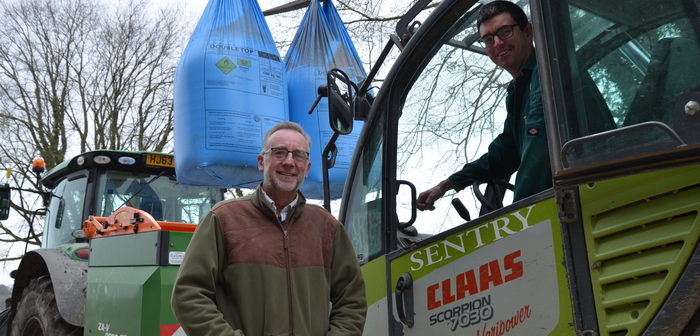In a season made exceptionally difficult because of extreme wet weather followed by a hot, dry summer, one of the UK’s largest farming companies has benefited from their decision to switch to Ammonium Nitrate-based products after using urea and ammonium sulphate fertilisers for the previous two decades.
Ammonium Nitrate’s speed of uptake was a real benefit this year with yield results for spring barley in particular more than proving this, says Richard Peck, Sales and Development Manager for Sentry.
Despite the challenging conditions and resulting late drilling, their Cuckoo spring barley achieved yields up to 7.0t/ha with a final average of 5.5t/ha and zero rejections from malsters.
“The extended period of exceptionally cold, wet weather that lasted through until the end of April meant that when we were eventually able to get on the land, it was vital that Nitrogen was taken up by the crops very quickly, which would not have been the case with urea.
“Without AN working in our favour we would not have felt nearly as comfortable about the situation, in what has been the most difficult season that I have known in over 30 years of farming.”
One of the UK’s largest farming companies, Sentry has some 200 directly managed, advisory and consultancy clients.
Based at Cerne Abbas near Dorchester, Richard is personally responsible for five farms in the South West totalling 1600 ha and for 20 years has purchased key inputs such as seed, agrochemical, fertiliser and machinery for all Sentry farms throughout the country.
“Our business is all about precision. We have 16,300 hectares under cultivation, from Leicester across to Norfolk, down to Kent and as far west as Dorset.
“Every farm is different, and every client is different in terms of their objectives and requirements, so we create a bespoke package for each one.
“We focus on technical expertise to optimise agronomy, apply the latest husbandry techniques and harness market intelligence to manage risk, improve our decision making and maximise farm incomes.”
Individual farm managers are highly trained, multi-talented individuals who run businesses that just happen to be farms, he explains.
“All are BASIS/FACTS-trained and have complete autonomy when it comes to deciding what crops to grow and what products to use on their farms, which differ vastly across the country.
“They each do their own budgets, formulate cropping plans and decide what inputs will be required to achieve their objectives.
“It is my job to collate that information and purchase those products on their behalf, on the most advantageous terms, so managers can focus on managing their farms and being innovative rather than having to waste time negotiating with dozens of local suppliers.”
Pooling purchases is much more efficient and provides much better control over input costs, Richard Peck explains.
“Sentry’s scale of operation creates huge purchasing power, which means that we are much better able to negotiate with a small number of very carefully selected suppliers.
“Farming is all about building relationships and we have been dealing with some of them for over 20 years. By ensuring that we talk to people with the authority to deal at our level we negotiate deals which work for both parties and short lines of communication allow any issues to be sorted out very quickly.”
Sentry is proud of its long-standing relationships with companies which Richard believes offer the best products or service in their sector.
“John Deere supply all our tractors, we operate Claas combines, crop protection products are sourced through Agrovista, seed comes through Agrii and combinable crops are marketed via Gleadell Agriculture.
“CF Nitram and DoubleTop and other fertilisers are sourced through Frontier who also supply all the nutritional advice required.”
This joined-up approach results in a win-win situation for all involved, he believes.
“Margins have been very tight in agriculture for some time and there is no one single silver bullet solution, so we are continually looking to make small, incremental improvements in every aspect of our business.
“In the late 1990s we switched to urea (46%N) and Ammonium Sulphate (21%N-60SO3) because the price per kilogram of Nitrogen from those sources was significantly lower than for AN-based products.
“That more than offset urea’s limitations, namely volatilisation, inferior product quality and less consistent spreading.
“Since then, the quality of these products has improved, depending on the country of origin, although we never felt there was a good reason to switch to any of the coated, slow-release urea products.
“We did test them, but our view was that if you are going to pay a premium for coated urea you might as well use Nitram.”
While liquids have their place, and are used on some farms for certain crops and situations, they are more expensive and it’s not possible to have sufficient tank capacity to store all N requirements on farm in that form, he says.
“That makes you totally dependent on an efficient supply chain, from the ships that bring UAN into the country to the lorries that deliver the finished product, so if any part of that fails, for any reason, you could end up with no Nitrogen.
“That’s a dangerous place to be, particularly as some of our FBTs have no farm buildings and would depend entirely on just-in-time deliveries.”
Last year, the decision was made to switch to Nitram (34.5%N) and DoubleTop (27N +30SO3), which are manufactured in the UK.
“We continually track input costs and AN had become much more competitive, so there were clear economic, agronomic and logistical arguments for changing back to these premium products.
“When the market opened in the summer 2017 we purchased all our AN fertiliser requirement for 2017/2018.
“For me, it’s all about quality and these deliver exactly what you would expect from premium products.
“They are truly uniform, with no lumps or dust, the contents of every bag are the same and they spread consistently at up to 36m, whereas urea is limited to 24m.
“The fact that AN does not volatilise, gets into the soil more quickly and is taken up by the crop much more rapidly than urea was invaluable this season.
“I certainly would not have felt as comfortable had we still been using urea, because you know that it will take longer to act, and time was something that no farm had this spring due to the exceptionally cold, wet weather.”
In fact it was 23rdApril before the drilling the Propino and Planet spring malting barley stated using a Claydon Hybrid drill with the last of it going in on 4th May, he recalls.
“Given such a late start, it was essential that the crop could access the nutrients it required as quickly as possible, so rather than apply some Nitrogen in the seedbed and some when the tramlines were visible, all the Ammonium Nitrate went onto the seedbed in the form of Nitram.
“From the moment it emerged the crop looked fantastic. It grew away rapidly and continued to do so in perfect condition right through to harvest.
“We didn’t skimp on inputs and gave it every opportunity to deliver, even applying a PGR despite the lack of rain. The crop matured naturally and we started cutting at the end of July, finishing in early August, at least four weeks earlier than in 2017.”
Given that spring barley was drilled so late and never received any rain to speak of the yields were exceptional, Richard says.
“Everything tells you that achieving up to 7.0t/ha from ‘cuckoo’ barley should be impossible, but that’s what we did, and it averaged 5.5t/ha.
“That was 1t/ha above budget and the price at harvest was £195 per tonne, with zero rejections. The bonus was being able to sell barley straw in the swath for £60 per acre and wheat straw at £100 per acre.”
At the start of April, the weather conditions here were so bad that it looked as if harvest 2018 would be a catastrophe, Richard says.
“I downgraded significantly all our farms’ budgets but given such a gloomy outlook back then, I was delighted with how the crops turned out.
“In this Southern Coastal belt they were generally very good, and the better the soils the better the crops. Oilseed rape yields were average, wheat yields were slightly down, but the spring barley was exceptional.”




